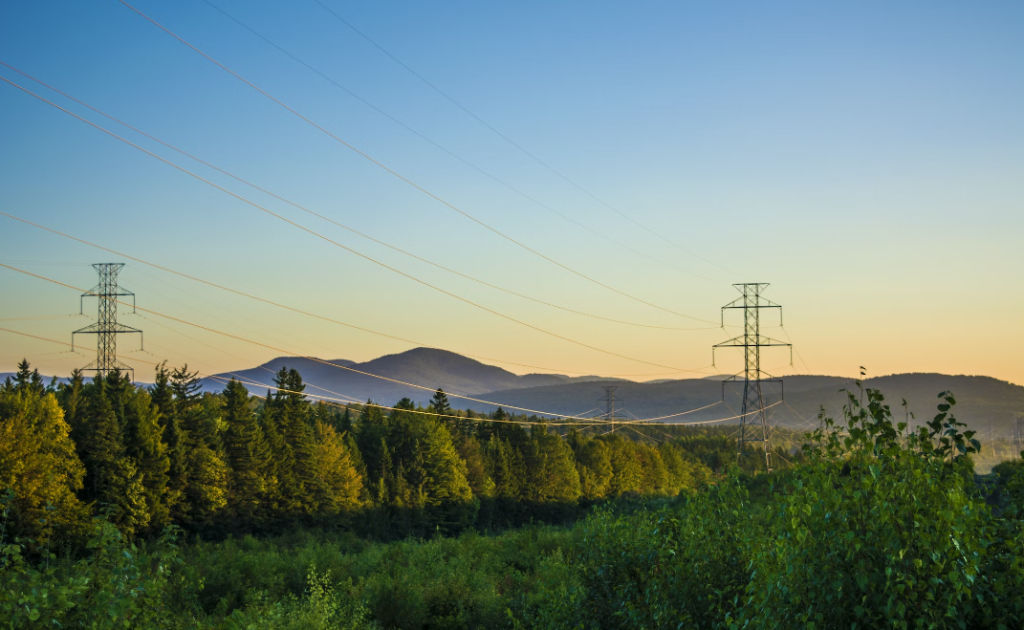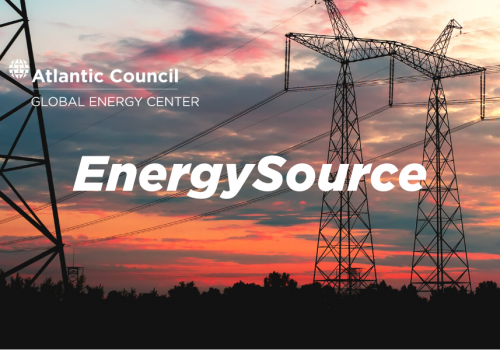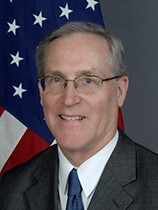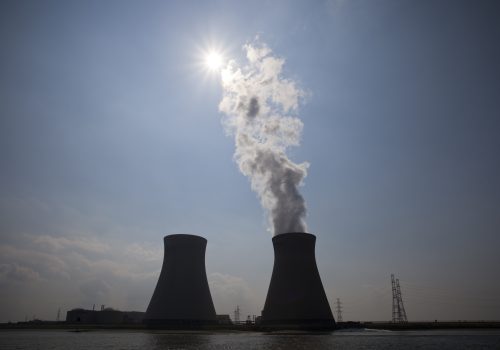Disruptions to global energy markets from Russia’s war in Ukraine have heightened energy security concerns and stimulated large-scale European gas diversification efforts, including through US liquified natural gas (LNG) supplies. Meanwhile, record high global temperatures and increasingly frequent extreme heat-related events in the United States and Europe have underscored another threat to the energy system, as power grids struggle under severe weather.
Both the United States and the European Union (EU)—which together account for 22 percent of global energy-related carbon emissions—have sought to stay on the path to net-zero emissions by 2050 as their economies feel the strain of both energy inflation and climate impact. This two-front war—against Russia’s disruption of energy supplies on the one hand and climate change on the other—are increasingly intertwined.
Electrification remains a powerful weapon in these battles, one in which the United States and European Union need to work together. To improve overall system reliability and resilience, both partners must decarbonize, meet new consumer and industrial demands, and expand transmission capacity.
The challenges are significant, with electricity-related emissions rising in 2022 and fossil fuels’ share of electricity generation remaining stubbornly high at 60 percent in the United States and 40 percent in the EU. The launch of the Inflation Reduction Act (IRA) in the United States and REPowerEU in the European Union represent historic government initiatives to spur clean electricity development and advance progress toward lofty targets of 100 percent carbon-free electricity by 2035 in the United States and reducing emissions 55 percent below 1990 levels by 2030 in the EU. Now these initiatives must be implemented with the utmost urgency.
Electricity sector developments in 2022
Last year, the United States and European Union continued their recoveries from the pandemic, albeit at slower rates of economic growth than in 2021. US end-use electricity consumption grew by 2.6 percent in 2022 to reach an all-time high of 4.05 trillion kilowatt-hours. In the EU, high electricity prices led to a decline of 3 percent in electricity consumption.
Strong growth in renewables was common to both sides of the Atlantic. Despite lower hydroelectric output, renewables accounted for the largest share of EU electricity generation at 39.4 percent, and solar and wind growth offset emergency increases in coal generation due to gas shortages. EU solar generation grew by 29 percent, with 20 member states achieving record shares.
In the United States, natural gas remained the largest source of utility-generated electricity at 39.8 percent, with an increase of 7 percent in 2022 due to hot weather and lower coal output. However, renewable generation grew faster, increasing by 12.6 percent. The share of renewables (21.5 percent) exceeded coal (19.5 percent) for the first time, courtesy of a doubling of solar capacity.
Despite growing renewable generation, electricity-related emissions increased in both the United States and the EU. US emissions from electricity grew slightly from 2021 but remain almost 40 percent down from their 2007 peak. The electricity sector contributed 31 percent of total US energy-related carbon dioxide emissions. Coal was the largest source of power sector emissions, comprising 55 percent.
While the share of fossil fuel generation declined by 1 percent in the United States due to falling coal use, it increased by 3 percent in the EU due to increased coal consumption, notably in Germany. Higher gas generation, especially in France, Italy, and Spain, also increased power-sector emissions.
The role of natural gas in supporting the electricity system remains contentious as the EU seeks to phase out of Russian gas by 2027, in part through imports of US LNG. For its part, US natural gas generation is expected to increase, but its share in the overall power mix will decline as renewable energy surges.
The essential role of nuclear power
The energy security and climate crises have changed attitudes toward nuclear power, as the essential role this zero-carbon source has to play in meeting future baseload electricity and heating needs becomes increasingly evident. Nuclear power contributed 46.3 percent and 37.7 percent of carbon-free power in the United States and the EU in 2022.
The closure of the Palisades plant in Michigan decreased US nuclear generation slightly in 2022 in both absolute and relative terms. Meanwhile in Europe, technical problems in France and closures in Germany led to falling output in 2022.
Despite last year’s dip, the prospect for a nuclear energy resurgence appears promising. One of two new Vogtle AP-1000 units in Georgia has finally entered operation. New third generation light-water reactors and advanced nuclear reactor projects are underway in both the United States and the EU. The US Congress has approved with bipartisan support billions of dollars in funding for maintaining existing plants and providing investment and production credits for new builds and commercial demonstrations.
Both utilities and industry are showing strong interest in small modular reactors (SMRs), which boast improved passive safety, standardized manufacturing, and operational flexibility. SMRs hold significant potential for producing electricity, high-temperature industrial heat, and clean hydrogen.
Most of these initial SMR projects will not be coming online before 2030 and their cost-competitiveness remains unclear. But just as the scale-up of solar photovoltaics has rapidly reduced costs and revolutionized the electricity industry, the potential for advanced manufacturing of small nuclear reactors to drive down prices, reduce construction times, and expand the scope of both centralized and distributed applications is substantial.
Infrastructure investment requirements
Renewable energy will continue to dominate new capacity additions as the United States and the EU implement ambitious clean energy programs. The impact of these initiatives is already apparent. US solar capacity is expected to grow by 32 gigawatts (GW) in 2023 and 31GW in 2024, overtaking US wind capacity around 2030. In Europe, solar capacity is expected to double by 2026 in line with REPowerEU’s target of 400GW by 2025. Both areas envision large expansion of offshore wind generation, with the US Department of Energy aiming for 20GW by 2030 and European leaders targeting 120GW in the North Sea by 2030.
To support this new renewable capacity, major investments are needed in transmission, distribution, and storage. Moreover, accommodating increased intermittency in the system while integrating electric vehicles, heat pumps, data centers, and microgrids will require measures to improve reliability and resilience.
As much as $90 billion in investment is needed in the United States by 2030 to support transmission. The $2.5 billion Transmission Investment Loan Fund and other measures included in the Bipartisan Infrastructure Law and the IRA will help, but utilities must also ramp up their own investments. Eurelectric, an industry group, suggests up to €425 billion may be needed for distribution alone in the EU by 2030, concluding that 70 percent of renewables are likely to be directly connected to distribution networks.
The financing requirements of the transition in the US and EU electricity sectors are substantial. Yet the costs of severe climate events are increasing daily. Over the past eight years, the United States has experienced ten climate events that have each caused $10 billion or more in damage. Costs from storm damage are estimated at $165 billion in 2022 alone, and over $1.1 trillion over the past decade. These impacts are becoming worse; even with 2023 not yet over, the United States through September 11 has experienced 23 extreme weather events costing over $1 billion each.
Looking ahead
Last year marked an important milestone in the energy transition in the United States and European Union with the passage of landmark energy and climate legislation. The focus now should be to implement these policies effectively and equitably to preserve momentum. Both the United States and the European Union face major political and economic challenges in achieving these goals.
The war in Ukraine and its energy implications will test Western resolve and require a continued focus on helping allies diversify energy supplies. The election season and confrontations over budgets and policy directions will preoccupy US decisionmakers and likely affect energy programs and project support.
Nevertheless, industry and financial institutions in both regions are embracing the clean energy transition. But workforce constraints are proving to be a considerable impediment to implementation, and an internal industrial policy focus on US and European markets may limit pursuing global clean energy opportunities.
Governments and the private sector in the United States and Europe must realize the importance of global sustainable development and climate mitigation efforts, especially in coal-dependent Asia. As US special presidential envoy for climate John Kerry and executive director of the International Energy Agency Fatih Birol recently warned in a Washington Post editorial, efforts to triple renewable electricity generation must be accompanied by a shared, intense commitment to stop the growth of unabated coal use.
Finally, the extreme global heat and flooding experienced in 2022 and 2023 demand greater global investment in clean energy alternatives. The upcoming COP28 climate summit in Dubai presents another opportunity to galvanize and mobilize global action and resources. The United States and Europe must seize this opportunity to persist in their twin struggles against climate change and the weaponization of energy supply.
Dr. Robert F. Ichord, Jr. is a nonresident senior fellow at the Atlantic Council Global Energy Center
Meet the author
Related content
Learn more about the Global Energy Center

The Global Energy Center develops and promotes pragmatic and nonpartisan policy solutions designed to advance global energy security, enhance economic opportunity, and accelerate pathways to net-zero emissions.
Image: Transmission lines. (Jaël Vallée, Unsplash) https://unsplash.com/photos/BvpTdaKbCcQ





